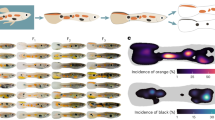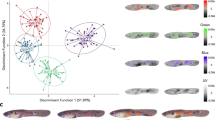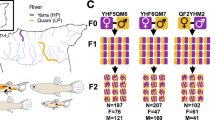Abstract
This paper tests the hypothesis that fluctuating asymmetry in exaggerated sexual traits is a sensitive indicator of genetic stress. Inbreeding was used to create genetic stress in two populations of male guppies collected from the Aripo and Paria river basins in Trinidad. Fluctuating asymmetry in the size of carotenoid, melanin and iridescent pigments did not differ between inbred and control males. There was also no difference in spot asymmetry. The lack of response was not caused by inbreeding having no effect on the male phenotype. Inbred Aripo males had less melanin pigment, fewer melanin spots and fewer iridescent subspots, and Paria males had less carotenoid pigment. Our results show that sexual coloration in guppies is sensitive to genetic stress caused by inbreeding, but they provide no support for the hypothesis that genetic stress is reflected particularly well by the degree of fluctuating asymmetry. The different response to inbreeding in the two populations is interesting. There was inbreeding depression in the area of carotenoid pigment in the Paria population, in which this characteristic is known to influence female mate choice, whereas there was no inbreeding depression in the Aripo population, in which females show no detectable preference for carotenoid pigments.
Similar content being viewed by others
Article PDF
References
Andersson, M B. 1994. Sexual Selection Princeton University Press, Princeton, NJ.
Charlesworth, D, and Charlesworth, B. 1987. Inbreeding depression and its evolutionary consequences. Ann Rev Ecol Syst, 18, 237–268.
Clarke, G M. 1995. Relationships between developmental stability and fitness: application for conservation biology. Conserv Biol, 9, 18–24.
Clarke, G M, Oldroyd, B P, and Hunt, P. 1992. The genetic basis of developmental stability in Apis mellifera: heterozygosity vs. genie balance Evolution, 46, 753–762.
Cuthill, I C, Swaddle, J P, and Witter, M S. 1993. Fluctuating asymmetry. Nature, 363, 217–218.
Endler, J A. 1978. A predator's view of animal color patterns. Evol Biol, 11, 319–364.
Endler, J A. 1980. Natural selection on color patterns in Poecilia reticulata. Evolution, 34, 76–91.
Fajen, A, and Breden, F. 1992. Mitochondrial DNA sequence variation among natural populations of the Trinidad guppy, Poecilia reticulata. Evolution, 46, 1457–1465.
Fowler, K, and Whitlock, M C. 1994. Fluctuating asymmetry does not increase with moderate inbreeding in Drosophila melanogaster. Heredity, 73, 373–376.
Houde, A E. 1988a. Genetic difference in female choice between two guppy populations. Anim Behav, 36, 510–516.
Houde, A E. 1988b. The effects of female choice and male-male competition on the mating success of male guppies. Anim Behav, 36, 888–896.
Houde, A E, and Endler, J A. 1990. Correlated evolution of female mating preferences and male color patterns in the guppy Poecilia reticulata. Science, 248, 1405–1408.
Houde, A E. 1992. Sex-linked heritability of a sexually selected character in a natural population of Poecilia reticulata (Pisces: Poecilidae) (guppies). Heredity, 69, 229–235.
Leary, R F, Allendorf, F W, and Knudsen, L K. 1984. Superior developmental stability of heterozygotes at enzyme loci in salmonid fishes. Am Nat, 124, 540–551.
Mather, K. 1953. Genetic control of stability in development. Heredity, 7, 297–336.
Møller, A P. 1990. Fluctuating asymmetry in male sexual ornaments may reliably reveal male quality. Anim Behav, 40, 1185–1187.
Møller, A P. 1992. Female swallow preference for symmetrical male sexual ornaments. Nature, 357, 238–240.
Møller, A P, and HöGlund, J. 1991. Patterns of fluctuating asymmetry in avian feather ornaments: implications for models of sexual selection. Proc R Soc B, 245, 1–5.
Møller, A P, and Pomiankowski, A. 1993. Fluctuating asymmetry and sexual selection. Genetica, 89, 267–279.
Nicoletto, P F. 1995. Offspring quality and female choice in the guppy, Poecilia reticulata. Anim Behav, 49, 377–387.
Parsons, P A. 1990. Fluctuating asymmetry: an epigenetic measure of stress. Biol Rev, 65, 131–145.
Palmer, A R, and Strobeck, C. 1986. Fluctuating asymmetry: Measurement, analysis, patterns. Ann Rev Ecol Syst, 17, 391–421.
Reeve, E C R. 1960. Some genetic tests on asymmetry of sternopleural chaeta number in Drosophila. Genet Res, 1, 151–172.
Reynolds, J D, Gross, M R, and Coombs, M J. 1993. Environmental conditions and male morphology determine alternative mating behaviour in Trinidadian guppies. Anim Behav, 45, 145–152.
Sas Institute Inc. 1996. JMP Statistical Discovery Software. Version 3.1.6. SAS Institute, Cary, NC.
Sokal, R R, and Rholf, F J. 1995. Biometry, 3rd edn. W. H. Freeman, New York.
Soulé, M E. 1979. Heterozygosity and developmental asymmetry: another look. Evolution, 33, 396–401.
Soulé, M E. 1982. Allomeric variation 1. The theory and some consequences. Am Nat, 120, 751–764.
Swaddle, J P, and Cuthill, I C. 1994a. Female zebra finches prefer symmetric males. Nature, 367, 165–166.
Swaddle, J P, and Cuthill, I C. 1994b. Female zebra finches prefer males with symmetrically manipulated chest plumage. Proc R Soc B, 258, 267–271.
Author information
Authors and Affiliations
Corresponding author
Rights and permissions
About this article
Cite this article
Sheridan, L., Pomiankowski, A. Fluctuating asymmetry, spot asymmetry and inbreeding depression in the sexual coloration of male guppy fish. Heredity 79, 515–523 (1997). https://doi.org/10.1038/hdy.1997.191
Received:
Issue date:
DOI: https://doi.org/10.1038/hdy.1997.191
Keywords
This article is cited by
-
Sex-specific effects of inbreeding on body colouration and physiological colour change in the cichlid fish Pelvicachromis taeniatus
BMC Ecology and Evolution (2022)
-
Laterality in modern medicine: a historical overview of animal laterality, human laterality, and current influences in clinical practice
European Journal of Plastic Surgery (2022)
-
Integument coloration signals reproductive success, heterozygosity, and antioxidant levels in chick-rearing black-legged kittiwakes
Naturwissenschaften (2011)
-
Inbreeding, energy use and sexual signaling
Evolutionary Ecology (2010)
-
Outbreeding causes developmental instability in Drosophila subobscura
Evolutionary Ecology (2010)



